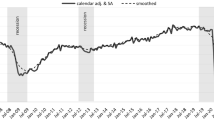Abstract
When analyzing business cycle data, one observes that the relevant predictor variables are often highly correlated. This paper presents a method to obtain measures of importance for the classification of data in which such multicollinearity is present. In systems with highly correlated variables it is interesting to know what changes are inflicted when a certain predictor is changed by one unit and all other predictors according to their correlation to the first instead of a ceteris paribus analysis. The approach described in this paper uses directional derivatives to obtain such importance measures. It is shown how the interesting directions can be estimated and different evaluation strategies for characteristics of classification models are presented. The method is then applied to linear discriminant analysis and multinomial logit for the classification of west German business cycle phases.
This work has been supported by the Collaborative Research Center ‘Reduction of Complexity in Multivariate Data Structures’ (SFB 475) of the German Research Foundation (DFG).
Access this chapter
Tax calculation will be finalised at checkout
Purchases are for personal use only
Preview
Unable to display preview. Download preview PDF.
Similar content being viewed by others
References
ENACHE, D. and WEIHS, C. (2005): Importance Assessment of Correlated Predictors in Business Cycles Classification. In: C. Weihs and W. Gaul (Eds.): Classification: The Ubiquitous Challenge, Springer, Heidelberg, 545–552.
HEILEMANN, U. and MÜNCH, H. J. (1996): West german business cycles 1963–1994: A multivariate discriminant analysis. In: CIRET-Conference in Singapore, CIRET-Studien 50.
KRUSKAL, W. (1987): Relative importance by averaging over orderings. The American Statistician, 41, 6–10.
LINDEMAN, R. H., MERENDA, P. F., and GOLD, R. Z. (1980). Introduction to Bivariate and Multivariate Analysis. Scott Foresman, Glenview, IL.
NETER, J., WASSERMANN, W., and KUNTER, M.H. (1990): Applied Linear Statistical Models: Regression, Analysis of Variance, and Experimental Designs, 3rd ed., Richard D Irwin.
WEIHS, C. and GARCZAREK, U. (2002): Stability of multivariate representation of business cycles over time. Sonderforschungsbereich 475, Technical Report 20/2002, University of Dortmund.
Author information
Authors and Affiliations
Editor information
Editors and Affiliations
Rights and permissions
Copyright information
© 2006 Springer Berlin · Heidelberg
About this paper
Cite this paper
Enache, D., Weihs, C., Garczarek, U. (2006). Classification-relevant Importance Measures for the West German Business Cycle. In: Spiliopoulou, M., Kruse, R., Borgelt, C., Nürnberger, A., Gaul, W. (eds) From Data and Information Analysis to Knowledge Engineering. Studies in Classification, Data Analysis, and Knowledge Organization. Springer, Berlin, Heidelberg. https://doi.org/10.1007/3-540-31314-1_57
Download citation
DOI: https://doi.org/10.1007/3-540-31314-1_57
Publisher Name: Springer, Berlin, Heidelberg
Print ISBN: 978-3-540-31313-7
Online ISBN: 978-3-540-31314-4
eBook Packages: Mathematics and StatisticsMathematics and Statistics (R0)




